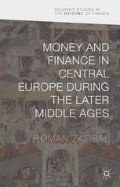Abstract
The town of Kremnica was founded by the merger of several smaller existing mining settlements, which were organized around the economic centre in Cremnychbana. Legally, the foundation date of the town is 17 November 1328, when King Robert granted it basic privileges including the privilege to expand its urban territory within a radius of two miles and the privileges of selfgovernance and judicial selfgovernment through the election of a mayor and twelve members of the town council known as aldermen (Geschworene , in German) (Juck, 1984, pp. 115–116, no. 136: 17 November 1328).1 Due to the extremely rich and profitable gold deposits there, a mining and mint chamber was established in Kremnica (and not in the nearby older and more traditional town of Banská Štiavnica). This fact indeed suggests the vital importance of the newly founded town. Kremnica’s gold production soon found its way onto the world markets in Italy, and to some extent, it affected the supply of precious metals and thus their European prices in the 14th century. At the same time it participated in the economic development of major business centres in late medieval Europe (Štefánik, 2011–2012, pp. 22–28). In the first century of its existence, the town grew at an unprecedented rate and became the head of the union of six and, after the accession of Banská Belá in the 15th century, of seven mining towns in Central Slovakia: Kremnica (German Kremnitz); Banská Štiavnica (Schemnitz); Banská Bystrica (Neusohl); Ľubietová (Libethen); Nová Baňa (Königsberg); Pukanec (Pukkantz); Banská Belá (Dilln) (Bolerázsky and Vozár, 1965, pp. 93–94; Štefánik and Lukačka, 2010, pp. 220, 228 note 199).
Access this chapter
Tax calculation will be finalised at checkout
Purchases are for personal use only
Preview
Unable to display preview. Download preview PDF.
Bibliography
V. Bolerázsky and J. Vozár (1965). ‘Sväz stredoslovenských banských miest’ Historický zborník kraja, II, Banská Bystrica: Stredoslovenské vydavateľstvo, pp. 87–116.
I. Draskóczy (2004). ‘Der ungarische Goldgulden und seine Bedeutung im ungar-ischen Außenhandel des 14.und 15. Jahrhunderts’ in R. Tasser and Ekkehard Westermann (eds.) Der Tiroler Bergbau und die Depression der europäischen Montanwirtschaft im 14. und 15. Jahrhundert. Innsbruck-Wien-München-Bozen: StudienVerlag, pp. 210–226.
D. Dvořáková (2007). ‘Království zlatého florénu. Peníze ve středověkém Uherském království ve 14.15. století’ in T. Borovský, B. Chocholáč and P. Pumpr (eds.) Peníze nervem společnosti. K finančním pomérúm na Moravě od poloviny 14. do počátku 17. Století. Brno: Matice moravská, pp. 22–59.
G. Fejér (1834). Codex diplomaticus Hungariae ecclesiasticus et civilis, vol. X/1. Budae: Typistypogr. Regiae Universitatis Ungaricae.
L. Fejérpataky (1885). Magyarországi városok régi számadáskönyvei. Budapest: Kiadja a Magyar Tudományos Akadémia.
L. Huszár (1979). Münzkatalog Ungarn von 1000 bis heute. Budapest: Corvina.
V. János, M. Bak, P. Engel and J. Ross Sweeney (eds.) (1992). Decreta regni mediae-valis Hungarie II (1301–1457). Salt Lake City: Charles Schlacks jr. Publisher.
Ľ. Juck (1984). Výsady miest a mestečiek na Slovensku (1238–1350). Bratislava: Veda SAV.
P. Križko (1964). ‘Kremnická komora a jej grófi’ in D. Lehotská (ed.) Z dejín banských miest na Slovensku. Bratislava: Vydavateľstvo SAV, pp. 281–323.
T. Lamoš (1969). Vznik a počiatky banského a mincového mesta Kremnice 1328–1430. Banská Bystrica: Stredoslovenské vydavateľstvo.
M. Matunák (1928). Z dejín slobodného a hlavného banského mesta Kremnice. Kremnica: Slobodné a hlavné mesto Kremnica.
A. Pohl (1974). Ungarische Goldgulden des Mittelalters (1325–1540). Graz: Akademische Druck und Verlagsanstalt.
M. Štefánik and J. Lukačka (2010). Lexikon stredovekých miest na Slovensku. Bratislava: Historický ústav Slovenskej akadémie vied.
M. Štefánik (2004). ‘Die Anfänge der slowakischen Bergstädte. Das Beispiel Neusohl’ in K. H. Kaufhold and P. Johanek (eds.) Stadt und Bergbau. Städteforschung. Veröffentlichungen des Instituts für vergleichende Städtegeschichte in Münster, Reihe A: Darstelungen, Bd. A/64, Köln–Weimar–Wien: Böhlau, pp. 295–312.
M. Štefánik (2011–2012). ‘Italian involvement in metal mining in the central Slovakian Region, from the thirteenth century to the Reign of King Sigismund of Hungary’. I Tatti Studies. Essays in the Renaissance. The Harvard University Center for Italian Renaissance Studies, vol. 1415. Florence: Leo S. Olschki, pp. 1146.
M. Štefánik (2012). ‘Výnosnosť kremnického zlatého baníctva v začiatkoch povrchovej ťažby v 1. polovici 14. Storočia’ in Argenti fodina 2011. The proceedings of the International Conference Argenti fodina 2011, which was held from September 7 to September 9, 2011 in Banská Štiavnica. Banská Štiavnica: Slovak Mining Museum, pp. 107–109.
N. C. Tóth (ed.) (2007). Zsigmondkori oklevéltár, vol. X. Budapest: Magyar Országos Levéltár.
Editor information
Editors and Affiliations
Copyright information
© 2016 Martin Štefánik
About this chapter
Cite this chapter
Štefánik, M. (2016). The Kremnica Town Book of Accounts: The Economy of a Mining and Mint Town in the Kingdom of Hungary. In: Zaoral, R. (eds) Money and Finance in Central Europe during the Later Middle Ages. Palgrave Studies in the History of Finance. Palgrave Macmillan, London. https://doi.org/10.1057/9781137460233_4
Download citation
DOI: https://doi.org/10.1057/9781137460233_4
Publisher Name: Palgrave Macmillan, London
Print ISBN: 978-1-349-56703-4
Online ISBN: 978-1-137-46023-3
eBook Packages: Economics and FinanceEconomics and Finance (R0)

